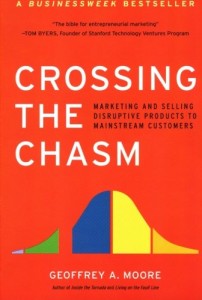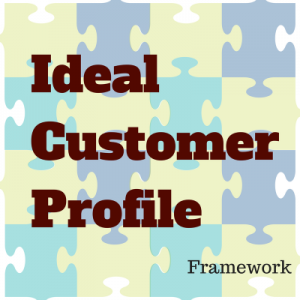Good email copy is important. In 2015, I wrote over 40 posts on various aspects of good cold email copy. But even with the best copy but no people to send it to — we’re stuck. So except for good copy, we need a list of contacts for our outbound prospecting.
Outbound prospecting isn’t easy. Building a prospect list is hard. It requires lots of time and effort. And with respect to your time and effort, there’s one thing you need to do before you roll up your sleeves and start collecting contacts. Actually, it’s a question you need to answer to yourself. Here’s the question and how to find the answer.
Question: “Who is the person you would want as your client?”
An off-the-cuff answer: “Whoever wants my product or service and is willing to pay for it (preferably a lot of money for a long period of time).”
If that’s your answer to this question, you sooo need to keep reading…
That seems to be a quite common answer to this question. Even if we don’t say it out loud, we think that to ourselves. And even if we don’t articulate it at all, we often act upon this definition of our client, even before investing our efforts in outbound prospecting.
And no wonder about that. Because that’s what feels natural and intuitive:
Business can only exist thanks to paying customers. Without the customers, there’s no business. Whoever wants to pay for our product or service is most welcome to do so. We feel like we shouldn’t miss any opportunity to get a new paying customer. Whoever they are.
But…
The problem with this definition of a customer starts when we realize that the customers won’t just spontaneously crowd around our product or service eager to use it and pay for it. They won’t just magically appear.
It is we who need to make sure the customers will be there.
We need to create the demand for our product or service among a group of people. We need to attract them. We need to earn their trust. We need to make them succeed thanks to our product or service. And only that’s how we may let them be willing to pay for what we’re offering.
Now, see what happens when we take the “whoever” part from our off-the-cuff definition of a customer and try to fit it in the “we need to…” sentences above:
- We need to create the demand for our product or service among a non-specified group of people (i.e. whoever).
- We need to attract whomever.
- We need to earn whoever’s trust.
- We need to make whoever succeed thanks to our product or service.
- And that’s how we may let whoever be willing to pay for what we’re offering.
It seems like our tasks as marketers, sales people and product/service providers become barely achievable, assuming the client we want is whoever that pays.
How to make our tasks achievable?
First of all, we need to realize that our off-the-cuff definition of a customer sucks. It’s too broad and too vague. It doesn’t allow us, as marketers and sales people, to imagine the person we are actually going to market and sell to. And we won’t generate any sales leads without knowing who to target.
We need something more specific than “whoever pays” as a definition of our potential customer. To get a more specific definition, we can revise the initial question by adding just one word to it:
Question Revised: “Who is the person you would ideally want as your client?”
That changes the perspective a little, doesn’t it?
Suddenly, we don’t just focus on those who pay. Instead, we can think of a whole list of characteristics that would be “nice to have” in a customer, to say the least.
Suddenly, we realize the answer may be much more complex.
Answer Revised: “We would ideally want our customer to:
a) have a nagging pain we can help them solve — and be aware of the pain
b) be willing to make some changes in their workflow to ease the pain
c) be capable of noticing the value our solution brings them, and
d) be ready to pay for the value
d) be willing to share their feedback on the solution with us
e) be willing to spread the word about the solution and the value they gain using it among similar people and organizations.”
Now we’re not looking for a whomever. We’re looking for companies and individuals with a specific set of business characteristics and personal traits.
What the business characteristics and personal traits namely are, depends on the specifics of our own business.
So, to be more practical and future-oriented, we should add one more part to our revised question:
Question re-revised : “Who is the person you would ideally want as your client, and why them exactly?”
The answer to this question is far more complex than the two above. And to find the answer, you need to stop and think of your business as a whole and of your ideal customer in detail.
We did that at Woodpecker some time ago, and we used 2 resources to make the process better-guided and organized. And these are the resources we highly recommend.
The two resources that helped us define our ideal prospects
1. Crossing the Chasm by Geoffrey A. Moore

The book was originally written in 1990, but it’s been revised twice so far, in 1999 and 2014. We’ve got the 2014 version, and that’s the one you want to have, as it contains updated examples of companies that applied the methodology described in the book.
I love marketing approaches based on observation of customers’ behavior, and that’s one of them. I love theories embracing the obvious patterns and making the reader realize they should not ignore those patterns, and that’s one of such theories. I appreciate publications that give you not only the theoretical basics, but also detailed practical guidelines, and that’s one of them.
A little about what the book will help you with:
- understand how the market for a B2B innovative technology products is structured
- discover how the market structure affects your marketing and sales efforts
- realize why you don’t want to sell to everyone at once, but to a chosen smaller market
- learn how to choose the smaller market you want to focus on at first
- plan how to provide your customers with a full product to bring them value
Here’s a short review of the 1999 version, for you to quickly get the gist of the theory the book is about. And here’s te author himself talking about the approach described in the book.
[embedyt]https://www.youtube.com/watch?v=Zwh8ThUqeC8[/embedyt]
And if that’s not enough to get you encouraged, know that the way Geoffrey Moore writes about marketing made me one of his fans right away. The analogies he uses are exceptionally accurate and often hilarious. It’s a great book to get a deeper understanding of the IT market and a fuller image of how your marketing and sales processes may be framed to match the market’s natural patterns and satisfy its requirements.
2. Ideal Customer Profile by Lincoln Murphy

That’s a blog post Lincoln Murphy published on his site sixteenventures.com some time ago and has lately updated for the first quarter of 2016.
The Ideal Customer Profile (ICP) Framework includes a list of specific questions you should ask yourself and crucial aspects you should take into consideration when choosing who you want to offer your product/service to.
In a B2B domain, the ICP you should define before you get about creating your marketing personas, let alone focus on outbound prospecting. It’s something that will allow you to notice a broader perspective on your marketing and sales process, and at the same time, create a more specific image of who you want as your customers and why them.
The ICP Framework will help you:
- define who the ideal customer is for your type of business and your particular situation
- realize who the less-than-ideal customer is and why you don’t want to sell to them
- find out what the FOMO (fear of missing out) is and how to fight it
- organize the search for the ICP around 7 characteristics of an ideal customer
Lincoln Murphy’s ICP Framework is a base you need to start with not only if you want to do the most with your outbound prospecting, but also to minimize your churn rate and lower the costs of providing customer happiness in the long run.
What’s in it for you and your outbound prospecting efforts?
Four specific actions to take after reading this post and before getting around collecting your base of prospects:
1. Ask yourself the very important question:
Who is the person you would ideally want as your client, and why them exactly?
2. Read Crossing the Chasm by Geoffrey A. Moore and use the methodology described in it to find the appropriate market for your marketing and sales operations.
3. Read the Ideal Customer Profile Framework post by Lincoln Murphy and use the ICP spreadsheet to define your current ideal customer.
4. On the basis of the results from steps 2 and 3, answer the question you asked yourself in step 1, and stick to the answer when getting about outbound prospecting.
May the four actions be a good start for your 2016 sales process. I believe you have already come across Crossing the Chasm and/or Lincoln Murphy’s ICP. But have you actually taken some action after reading the two?
We have. We’ve been analyzing, brainstorming, and assessing our ideas. It wasn’t easy to find the time for this, but we managed to do that and it helped us a lot in terms of both marketing and sales.
We have a clearer vision of who our ideal prospects are, and so will you. So even if you know the two resources I mentioned in this post, take a second try on them and take some real action to update your assumptions on the customers you’re looking for your business.
Because there’s no point in starting the search if you’re not sure who you are actually looking for.
***
I’ll be focusing some more on prospecting hacks, tools and best practices in the nearest posts. We’ve noticed that this initial part of the cold emailing process has been a real drag for many Woodpecker users. We still have some learning to do while doing outbound prospecting, so I’ll share our findings and hope that they will appear helpful to you as well. Stay tuned!
READ ALSO

How to Make Prospecting More Productive with Google Sheets?
Desktop cluttered with dozens of CSV files, their copies, and copies of their copies. Sending CSVs back and forth between your team members. Time wasted on finding a way to stay organized despite the chaos. Sounds like a nightmare, right? Indeed, for many salespeople, it is a daily struggle. So why not ditch the CSVs for something easier to manage and more teamwork-friendly? For example, build your prospect list in Google Sheets and have it integrated with your follow-up automation tool? No more copying, importing and exporting. Let me show you how to make your prospecting more productive with the new Google Sheets integration, we’ve just rolled out.

How We Found Webinar Participants on Quora: Vol. 1
Before you venture into prospecting, you should have an ideal customer profile in place. However, what if you have an ICP worked out and you're stuck because you don't know where to search for prospects? Today, I'll show you that the online places you enjoy being at can lend itself perfectly to building a quality contact list. And that's based on Wojtek's, Head of Outbound Sales, experience.

Do You Know Your Prospects at All?
Do you know who your prospects are as people? What do they like? What do they care about? What are the things that they can’t stand? What are their personal and business goals? Here’s how we've found specific answers to all those questions for our business, and why finding those answers is so important for the success of your company.
